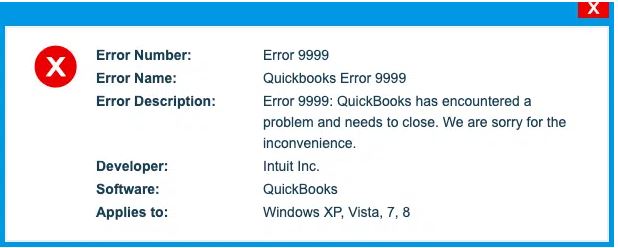Even the most robust and trusted accounting platforms like QuickBooks occasionally face obscure technical errors hampering productivity, as evidenced by the vague yet disruptive QuickBooks Banking Error 9999 arbitrarily arising during financial institution connectivity. While frustratingly opaque, decoding the source of errors like 9999 provides clarity on practical troubleshooting techniques users can employ to restore workflows rapidly – no advanced skills are needed.
Understanding what causes common bank feed integration failures allows small business owners to take control of resolutions rather than waiting indefinitely for external support. With the proper knowledge, QuickBooks users can overcome superficial platform conflicts in minutes through systematic self-diagnosis and repair methods, keeping data access smooth amidst temporary hiccups. Staying proactive is critical for turning runtime problems into long-term stability.
Resolve QuickBooks Error Code 9999
The QuickBooks “Error 9999” message that suddenly disrupts connectivity between financial institutions and QuickBooks stems from scripting failures blocking bank internet access required for cloud data flows. Specifically, 9999 crashes arise during bank feed updates, halting transaction syncs and remote collaboration. The error hangs integrated accounting system response by slowing or entirely stopping productivity. While the arbitrary numbering appears unintelligible, understanding root causes related to temporary bank API changes or firewall misconfigurations allows users to restore lost access themselves through simple resets or basic troubleshooting before needing to escalate support calls. A bit of decoding turns obtuse errors into actionable solutions, keeping business operations intact.

Solving QuickBooks Desktop Update Error 9999: Troubleshooting Messages
Encountering desktop screen error messages? Stay vigilant for alerts like “Sorry, we can’t update your account.
Please try updating again later. (9999)” or the succinct “Error code 9999 – Can’t update,” signifying potential updating challenges.

Signs of the QB Error Code 9999
QuickBooks users grappling with Banking Error Code 9999 often wonder about its causes. Several factors contribute to this issue, including a slow connection between the bank and the server due to poor internet connectivity. Issues may also arise if antivirus or firewall applications obstruct the connection between the QuickBooks server and the bank’s website. Additional triggers include excessive browser cache files and a Windows firewall blocking the bank website. Furthermore, errors on the bank’s end can lead to this issue and the accidental deletion of QuickBooks files. A comprehensive understanding of these factors is essential for effective troubleshooting.
Bullet Points:
- Slow internet connection affecting the bank-server link
- Antivirus or firewall hindrance in QuickBooks-server and bank website connection
- Accumulation of excessive browser cache files
- Windows firewall blocking the bank’s website
- Bank-related issues contributing to the error
- Accidental deletion of QuickBooks files
Identifying the root causes of resolving QuickBooks Error is the first step towards resolving the issue. Users should address connectivity issues, clear browser cache, check firewall settings, and ensure the integrity of QuickBooks files.
Quick Solutions for Fixing QuickBooks Banking Error Code 9999
Are you encountering QuickBooks Banking Error 9999? Worry not, as there are several solutions you can implement to resolve this issue. Let’s delve into each method step by step:
Method 1: Clear Browser’s Cache Files
For Google Chrome:
- Launch Google Chrome and go to the settings tab.
- Click on “Precise Browsing Data.”
- Move to “Cached Images and Files.”
- Click on “Clear Data” to delete the cache files.
For Firefox:
- Enter “about preferences#privacy” in the address bar.
- Click on “Clear Recent History.”
- Select “Cache” from the list.
- Click on “Clear Now.”
For Internet Explorer:
- Press Ctrl + Shift + Delete.
- Go to “Temporary Internet and Website Files.”
- Click on “Delete.”
Method 2: Use the System File Checker
- Click on the Windows key and enter the command in the search bar.
- Right-click on the Command Prompt and select “Run as Administrator.”
- Type “SFC/scan now” and press Enter.
- Restart the computer and check if the issue is resolved.
Implementing these methods should help you fix QuickBooks Banking Error 9999 and ensure smooth accounting operations.
Method 3: Repair Registry Files
Maintaining a healthy Windows registry is vital for smooth system operations. Quickly resolve any damaged registry files with these steps:
- Start by selecting the Start menu.
- Enter the command in the search box.
- Press Ctrl + Shift and click Enter.
- If prompted, click Yes.
- Enter “regedit” and click Enter.
- Click on the key associated with the registry issue.
- Proceed to the File menu.
- Hit Export and save the backup key in a folder.
- Choose the selected unit in the export range.
- Click Save, ensuring the .reg file extension is used.
- Make a backup of the registry entry to check for issue resolution.
Method 4: Update Bank Account
Updating the bank account multiple times can resolve the error. Follow these steps:
- Launch QuickBooks Online and select the Banking option.
- Choose the Update tab.
- Repeat the update action several times.
Method 5: Disconnect and Reconnect the Bank Account
- Select the Banking tab.
- Click Edit next to the account to disconnect.
- Choose Disconnect this Account and click Save and Close.
- Follow the onscreen steps.
- Click Add Account under the Bank tab.
- Enter bank account login information and select Continue.
- Click on the bank option and choose Securely Connect.
- Select the account type (credit card or bank account).
- Click Add New and Connect.
Implementing these methods can effectively address QuickBooks Banking Error 9999, ensuring seamless financial management
Check also – Essential Steps to Resolve QuickBooks Error 324
Conclusion QB Banking Error Code 9999
Should the issue persist, don’t hesitate to connect with our Support Team. This comprehensive guide has delved into various effective methods to resolve QuickBooks Banking Error 9999. We trust that this information has been valuable to you. If challenges persist or if you encounter any other issues, our dedicated QuickBooks online error support team is ready to assist. Contact us at our helpline, 1-888-656-2102, for prompt and personalized solutions to ensure uninterrupted financial management with QuickBooks.
What does QuickBooks Error Code 9999 Mean?
The error is a scripted interruption in the connection between your bank and QuickBooks online.
What should be done to fix the error in QuickBooks?
Select the transaction in the bookkeeping menu.
- Click on the banking option.
- Choose the bank to edit.
- Click on edit sign info.
- Update the info according to your needs.
How to Fix QuickBooks Error 9999?
- Update your bank.
- Transparent browser cache files.
- Reset the connection by disconnecting and reconnecting.
- Log in to your bank website using a web browser.
How Can I Increase My Daily Transfer Limit FNB?
- Log in to online banking.
- Select the “My Bank Account” tab.
- Choose a credit card.
- Click on the upgrade card or increase limit button.
What is the Transaction Limit?
The transaction limit is the maximum amount a merchant may initiate or authorize for a single entry or transaction.
